Are Sunflowers Hardy Annuals? Discover Their Resilient Nature
When planning your garden, you might wonder about the resilience of different plants. Sunflowers are a popular choice because of their bright, cheerful blooms. The big question is, are sunflowers hardy annuals? Sunflowers are indeed hardy as annuals, meaning they are tough and can handle a variety of growing conditions. This makes them a fantastic choice for gardeners looking for low-maintenance beauty.
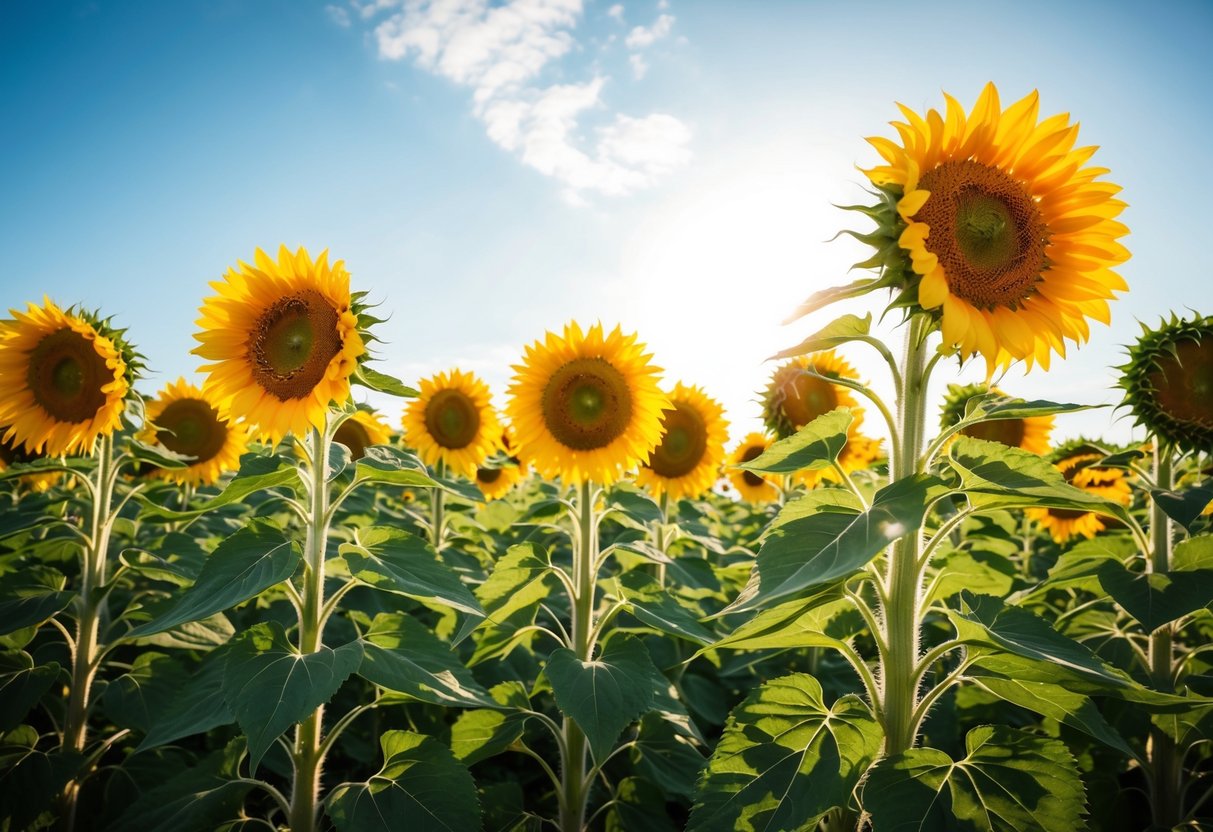
Gardeners love sunflowers for their ability to thrive in full sun and their minimal care requirements. Whether you’re growing them for their striking appearance or to attract birds with their seeds, these flowers are low-maintenance and rewarding to grow. Choosing sunflowers for your garden can add a splash of color and bring a smile to anyone who sees them. Their strength as annuals is perfect for those who want a reliable plant without the fuss.
Another reason to consider sunflowers is their versatility. With various types ranging from petite blooms to towering giants, you can select the variety that fits your space. This adaptability makes sunflowers an excellent addition to any garden setup, whether you’re a novice or an experienced gardener. They provide an opportunity for you to enjoy a bright, hardy plant with minimal effort and maximum impact.
What Makes Sunflowers Hardy Annuals
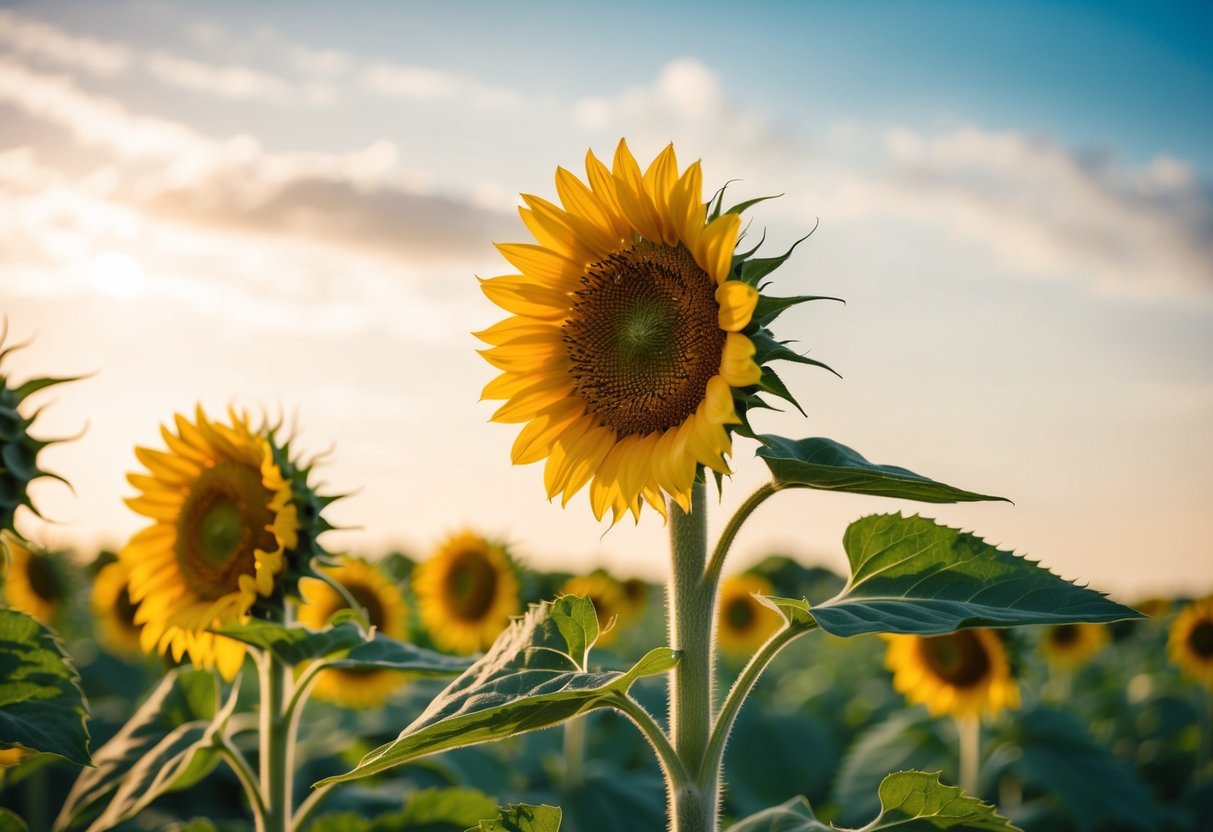
Sunflowers are known for their bright blooms and resilience in gardens. Understanding their classification as hardy annuals is key to successful growth. The Helianthus genus offers diverse varieties that thrive in different conditions.
Defining Hardy Annuals
Hardy annuals are plants that can withstand a bit of frost, making them a solid choice for cooler climates. These plants complete their life cycle within one year, but they’re robust enough to survive early spring chills. This means you can start planting them when the soil warms up, even if frost risk lingers. Sunflowers, being hardy annuals, can fit well into this category, offering beauty and strength without needing to be replanted each year.
The Helianthus Genus
Sunflowers belong to the Helianthus genus, which includes both annual and perennial varieties. The most common sunflower variety, often planted in flower gardens, is the annual Helianthus annuus. This variety is loved for its large, sunny blooms. While some Helianthus species are perennial, the annual types are admired for their ability to germinate, grow, and bloom in a single season. Understanding these distinctions can help you choose the right sunflower for your garden.
Seasonal Growth Cycle
The growth cycle of sunflowers starts with planting seeds in warmed soil in spring. Once the danger of frost has passed and soil temperatures reach at least 60 °F, seeds can go in the ground. Sunflowers grow quickly through the warm months, reaching impressive heights before blooming. As hardy annuals, they usually die off after flowering but can reseed themselves for future growth. This makes them an attractive choice for gardeners looking for vibrant summer blooms without yearly replanting hassle.
Cultivation and Care
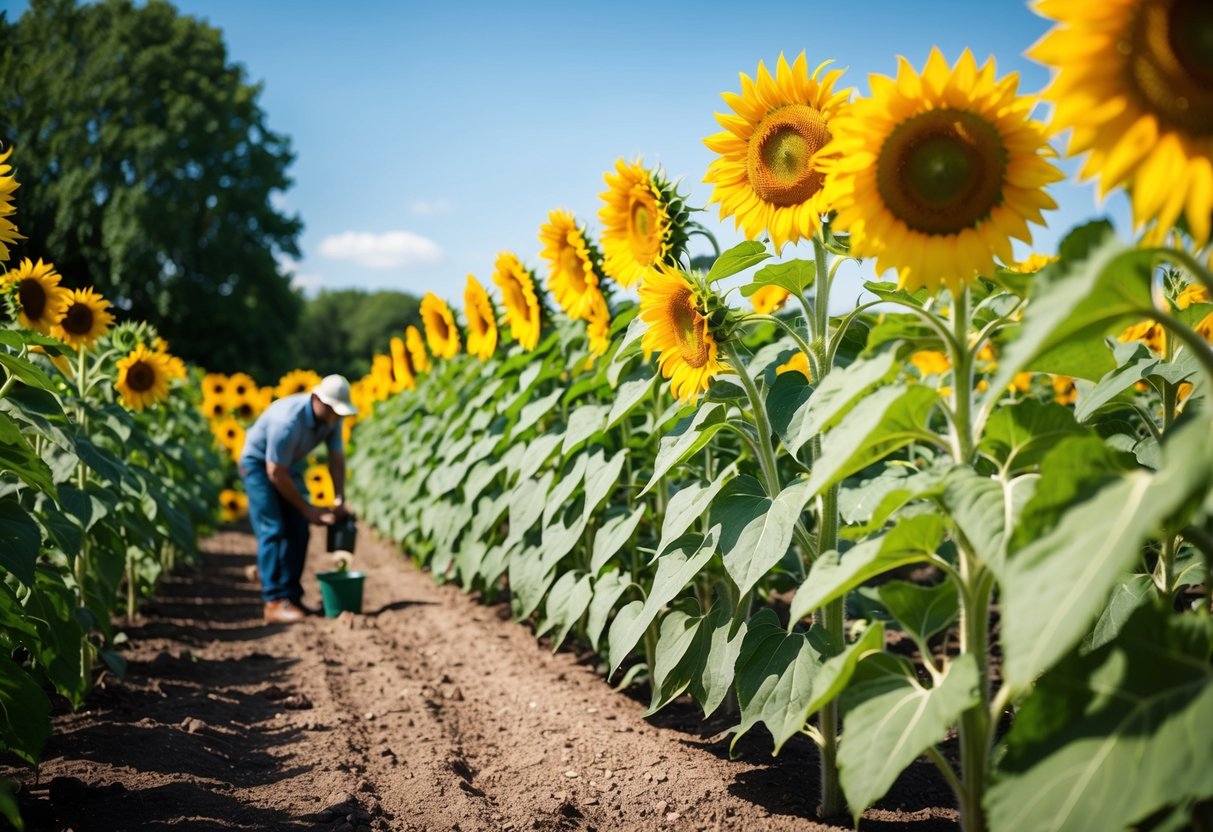
To grow healthy annual sunflowers, focus on providing the right conditions for sunlight and soil, regular watering and fertilizing, and protection against common pests and diseases. These steps will ensure your sunflowers thrive and display their vibrant blooms.
Sunlight and Soil Needs
Sunflowers love the sun. They require full sun for at least six to eight hours each day. Find a bright spot where your plants can soak up those rays.
When it comes to soil, choose a well-drained soil with a pH level between 6.0 and 7.5. This will help the roots absorb the necessary nutrients. Adding organic matter like compost can improve soil quality. Consider mulching around the base to retain moisture and keep weeds at bay.
Watering and Fertilizing
Consistent watering is key for sunflowers, especially in their early growth stages. Make sure the soil stays moist but never waterlogged. During hot months, you may need to water more frequently.
Fertilizer isn’t a must, but if you choose to use it, opt for a balanced, slow-release fertilizer. Apply it once during planting and again when the plants reach moderate height. This supports healthy growth and vibrant flowers.
Common Pests and Diseases
Sunflowers can sometimes face challenges from pests like aphids, caterpillars, and birds. Keep an eye on your plants and remove pests by hand or use insecticidal soap if needed.
Rust, a fungal disease, can affect sunflowers, especially in humid conditions. Look for brown spots on leaves. If this happens, improving air circulation and removing affected leaves can help. Regular inspection and sunflower care are crucial to maintaining the health of your plants.
Growth and Blooming
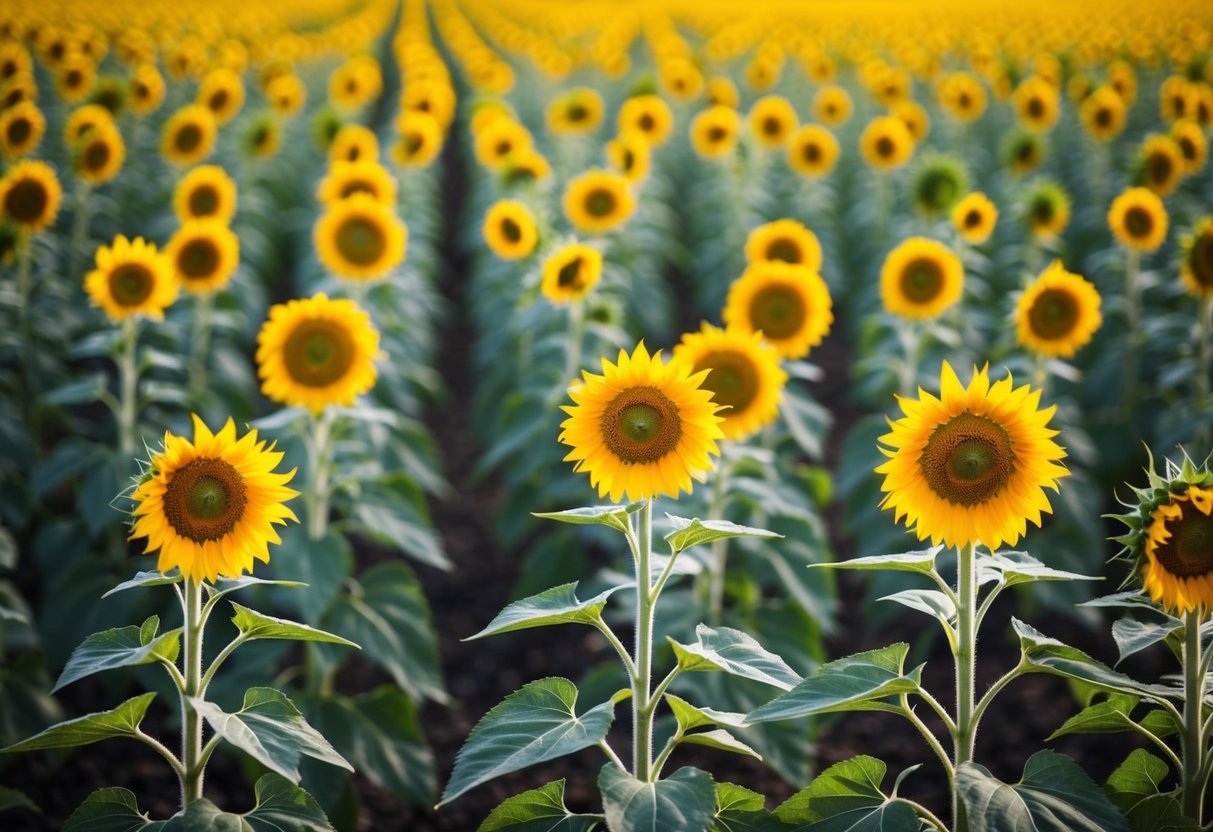
Sunflowers, especially Helianthus annuus, are fascinating plants with a unique lifecycle. Understanding how they grow and bloom can help you enjoy their bright, cheerful flowers from midsummer to early fall. This section provides insights into their journey from seeds to vibrant blooms.
From Seed to Bloom
When you plant sunflower seeds, they typically need soil temperatures of at least 60°F to germinate. It’s often best to plant them in the garden about three weeks after the last frost. Once the seeds germinate, seedlings emerge and begin their journey toward becoming tall plants with large, colorful flower heads.
As they grow, sunflowers reach their full height, sometimes up to 12 feet tall, depending on the variety. With adequate sunlight and water, these plants thrive, moving their broad leaves to follow the sun. This helps them capture energy for growth, leading to strong, healthy plants that will soon produce buds.
Sunflower Blooming Stages
Sunflower blooms open at different stages, both captivating and rewarding. Initially, buds form and gradually grow, hinting at the flowers to come. Once they bloom, their bright petals unfurl, revealing the central disk of tiny flowers. This stage usually occurs in midsummer when days are long and warm.
As blooming progresses, the flower head enlarges and fills with seeds. The seeds, nestled within the central disk, are ready for harvesting when they reach maturity. Throughout blooming, sunflowers attract pollinators, making them vibrant additions to your garden during the flowering period.
Maximizing Flowering Potential
To enhance your sunflowers’ blooming performance, ensure they have excellent care. Aim for a sunny location, as these flowers thrive in full sunlight.
Consistent watering helps maintain healthy growth and flower production. Keeping the soil moist but not waterlogged encourages optimal blooming.
Fertilizing can also boost their health. A light application of fertilizer, particularly as they begin to grow, can spur more robust blooms. Deadheading, or removing spent blooms, may encourage the plant to produce additional flowers. This step, although not always necessary, can extend the flowering period, letting you enjoy these stunning plants longer.
Types and Varieties
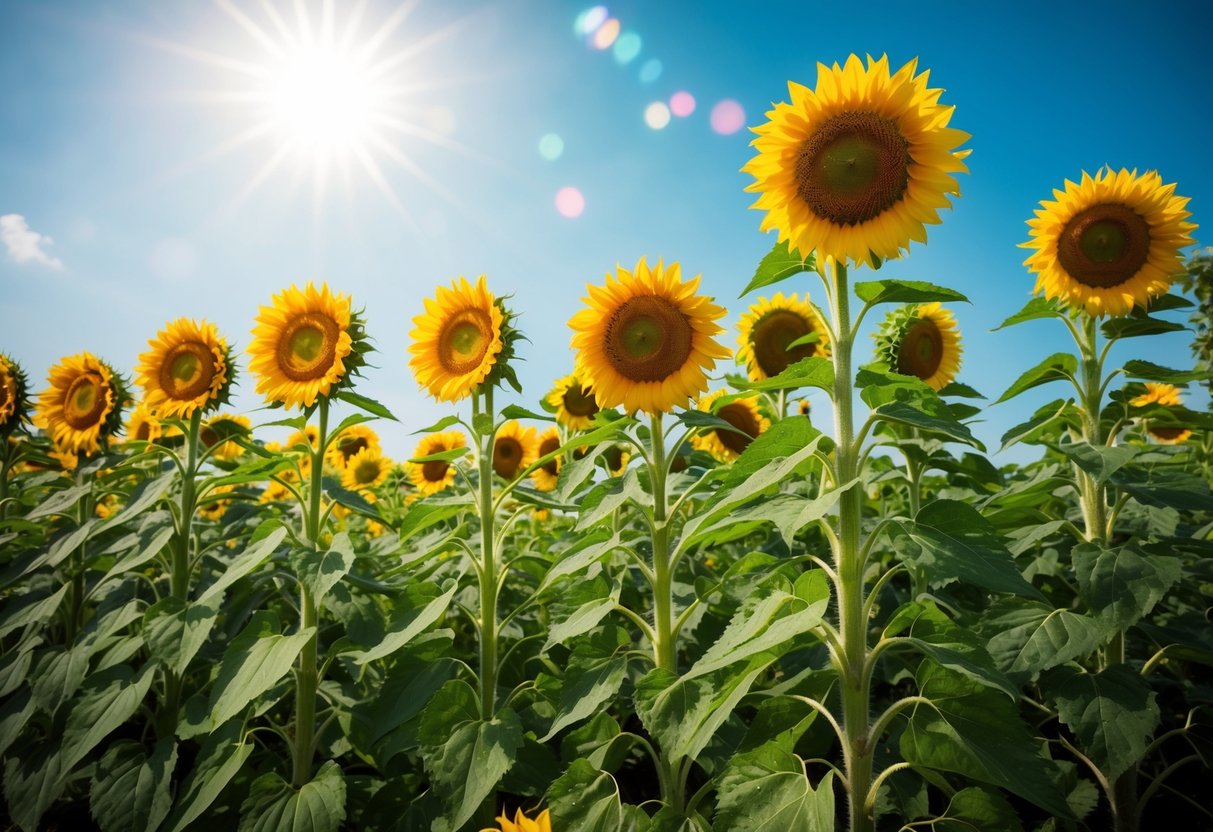
Sunflowers come in various types and sizes, adding vibrant colors and beauty to your garden. Knowing the differences between classic varieties, unique sunflowers, and how to choose the right one is essential for any gardener.
Classic and Popular Varieties
Classic sunflower varieties are well-loved for their tall stature and bright yellow blooms. The common sunflower (Helianthus annuus) is a favorite because of its large flowers and easy growing nature. If you’re after size, the American Giant reaches impressive heights and is perfect for dramatic garden displays.
Maximilian sunflowers are perennial and bloom late in the season, providing extended beauty with their golden-yellow flowers. They’re excellent if you prefer a more natural and prairie-inspired look.
The Teddy Bear sunflower stands out with its fluffy, double petals. This variety is smaller and great for bouquets. These traditional choices are reliable and will certainly bring cheerfulness to your outdoor space.
Unusual and Unique Sunflowers
For those looking to add something different to their garden, unique sunflower varieties can provide that wow factor. Rogue Royale sunflowers have striking red petals and are a branching type, meaning they produce numerous blooms throughout the season.
The Swamp sunflower (Helianthus angustifolius) is another unique option. It’s well-suited for moist habitats and can grow quite tall. This choice is not just beautiful but also supports native bees with its flowers.
Consider the Giant sunflower (Helianthus giganteus) if you’re interested in edible aspects. Its tubers and seeds can be food for both humans and wildlife. These distinctive sunflowers offer interesting shapes and colors, making your garden stand out.
Choosing the Right Sunflower for Your Garden
When selecting sunflowers for your garden, consider your space, climate, and the purpose you have in mind. For small gardens or containers, dwarf varieties like the Teddy Bear might be ideal.
If you’re looking for structural plants, the American Giant can provide vertical interest. To support local wildlife, you may want to plant Swamp sunflowers that thrive in wetter areas.
Planning for succession planting will ensure blooms throughout the summer. Checking hardiness zones and sunlight needs helps you make informed decisions for the best sunflower experience. Explore the possibilities, and select the varieties that match your garden’s character and your personal taste.
Wildlife and Ecological Benefits

Sunflowers offer several ecological advantages that enhance your garden’s overall health. They attract a variety of pollinators and wildlife, foster biodiversity, and make excellent companion plants.
Attracting Pollinators and Wildlife
Sunflowers are a magnet for pollinators like bees and butterflies. Their bright, cheerful blooms are full of nectar and pollen, providing essential food sources for these insects. Beyond this, their seeds attract bird species, making your garden more bird-friendly. You’ll often see finches and sparrows feasting on sunflower seeds. By planting sunflowers, you’re helping support essential ecosystems that depend on pollinators and birds for survival.
Sunflowers and Biodiversity
Incorporating sunflowers into your garden encourages biodiversity. Their tall structures and ample foliage provide shelter and food to diverse wildlife. This variety of animals and insects benefits the environment by maintaining ecological balance. Sunflowers promote healthy soil by enhancing beneficial soil microbes, which help other plants grow. Overall, they create a thriving mini-ecosystem that will enrich your garden.
Sunflowers as Companion Plants
Sunflowers are incredible companion plants. They pair well with marigolds, which deter pests. Sunflowers also pair well with cosmos, which enhance pollinator activity.
Sunflowers’ large leaves provide natural shade, benefiting plants that thrive in partial sunlight. They also support climbing plants by acting as natural stakes.
Their ability to enrich the soil helps other plants flourish, making sunflowers a valuable addition to your garden ecosystem.







